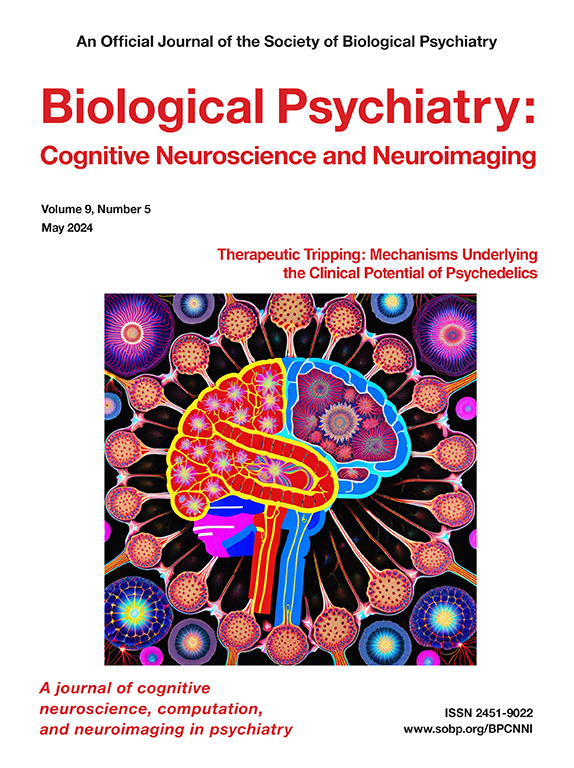Gamma Oscillations and Excitation/Inhibition Imbalance: Parallel Effects of NMDA Receptor Antagonism and Psychosis
IF 4.8
2区 医学
Q1 NEUROSCIENCES
Biological Psychiatry-Cognitive Neuroscience and Neuroimaging
Pub Date : 2025-07-01
DOI:10.1016/j.bpsc.2025.01.008
引用次数: 0
Abstract
Background
Auditory steady-state response (ASSR) abnormalities in the 40-Hz (gamma band) frequency have been observed in schizophrenia and in rodent studies of NMDA receptor (NMDAR) hypofunction. However, the extent to which 40-Hz ASSR abnormalities in schizophrenia resemble deficits in 40-Hz ASSR induced by acute administration of ketamine, an NMDAR antagonist, is not yet known.
Methods
To address this knowledge gap, we conducted parallel electroencephalography studies: a crossover, placebo-controlled ketamine drug challenge study with healthy participants (study 1) and a comparison of patients with schizophrenia and healthy control participants (study 2). Time-frequency analysis of the ASSR was used to calculate baseline, broadband gamma power, evoked power, total power, phase-locking factor, and phase-locking angle.
Results
Relative to healthy control participants, patients with schizophrenia exhibited increases in prestimulus broadband gamma power and reductions in 40-Hz ASSR evoked power, total power, and phase-locking factor, replicating previous studies. However, we failed to replicate previous findings of 40-Hz ASSR phase delay in schizophrenia. Relative to placebo, ketamine increased prestimulus broadband gamma power; reduced 40-Hz ASSR evoked power, total power, and phase-locking factor; and advanced the phase of the 40-Hz ASSR.
Conclusions
Normalized by their respective control groups/conditions, direct comparison of these measures between schizophrenia and ketamine data only revealed significant differences in phase, supporting the role of NMDAR hypofunction in mediating gamma oscillation abnormalities in schizophrenia.
γ振荡和兴奋/抑制不平衡:n -甲基d -天冬氨酸受体拮抗和精神病的平行效应。
背景:在精神分裂症和n -甲基d -天冬氨酸谷氨酸受体(NMDAR)功能减退的啮齿动物研究中,已经观察到40赫兹(伽马波段)频率的听觉稳态反应(ASSR)异常。然而,精神分裂症患者的40赫兹ASSR异常在多大程度上类似于急性给药氯胺酮(一种NMDAR拮抗剂)引起的40赫兹ASSR缺陷,目前尚不清楚。方法:为了解决这一知识差距,我们进行了平行脑电图研究:健康受试者的交叉、安慰剂对照氯胺酮药物刺激研究(研究1)和精神分裂症患者与健康对照受试者的比较(研究2)。ASSR的时频分析用于计算基线、宽带伽马功率、诱发功率、总功率、锁相因子和锁相角。结果:与健康对照相比,精神分裂症患者表现出刺激前宽带伽马功率增加,40hz ASSR诱发功率、总功率和锁相因子降低,与先前的研究重复。然而,我们未能重复先前在精神分裂症中发现的40 hz ASSR相位延迟。相对于安慰剂,氯胺酮:增加刺激前宽带伽马功率,降低40-Hz ASSR诱发功率、总功率和锁相因子,并提前40-Hz ASSR阶段。结论:在各自的对照组/条件下,直接比较精神分裂症和氯胺酮数据的这些指标仅在期相上存在显著差异,支持NMDAR功能低下介导精神分裂症γ振荡异常的作用。
本文章由计算机程序翻译,如有差异,请以英文原文为准。
求助全文
约1分钟内获得全文
求助全文
来源期刊

Biological Psychiatry-Cognitive Neuroscience and Neuroimaging
Neuroscience-Biological Psychiatry
CiteScore
10.40
自引率
1.70%
发文量
247
审稿时长
30 days
期刊介绍:
Biological Psychiatry: Cognitive Neuroscience and Neuroimaging is an official journal of the Society for Biological Psychiatry, whose purpose is to promote excellence in scientific research and education in fields that investigate the nature, causes, mechanisms, and treatments of disorders of thought, emotion, or behavior. In accord with this mission, this peer-reviewed, rapid-publication, international journal focuses on studies using the tools and constructs of cognitive neuroscience, including the full range of non-invasive neuroimaging and human extra- and intracranial physiological recording methodologies. It publishes both basic and clinical studies, including those that incorporate genetic data, pharmacological challenges, and computational modeling approaches. The journal publishes novel results of original research which represent an important new lead or significant impact on the field. Reviews and commentaries that focus on topics of current research and interest are also encouraged.
 求助内容:
求助内容: 应助结果提醒方式:
应助结果提醒方式:


